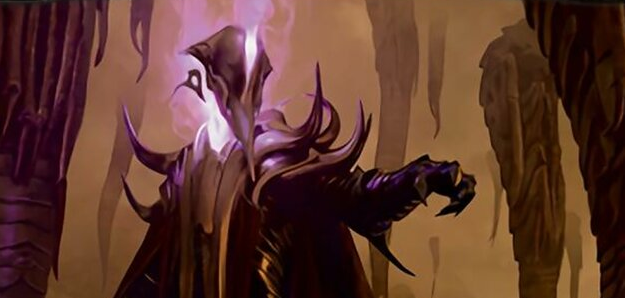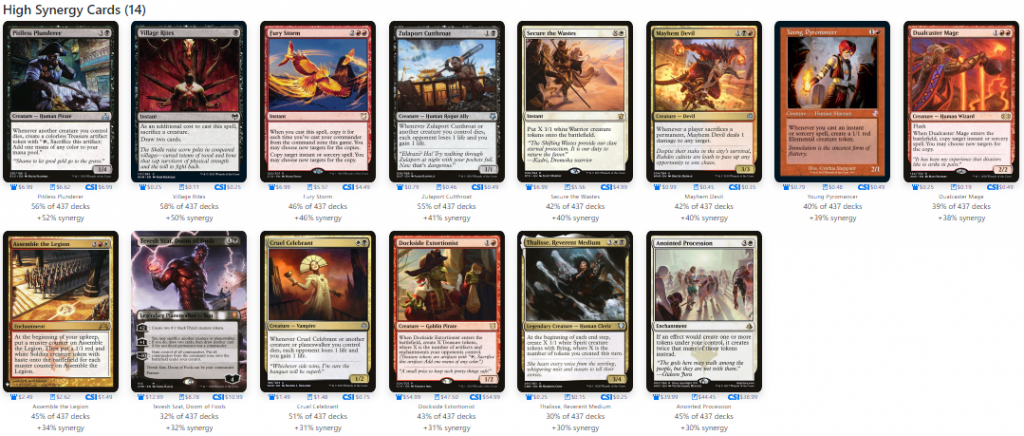Epic Experiment - Extus, Oriq Overlord

(Extus, Oriq Overlord | Art by Chase Stone and Kekai Kotaki)
Epic Preparation
Hello, EDHREC fans! I’m Bernardo Melibeu, and this is Epic Experiment, a series where we throw all common sense aside and experiment with some unusual strategies, changing how we normally build our deck. Is it going to work? Who knows?! We’re making science here. When you’re an Izzet mage, blowing things up is half the fun.
In this article, we'll be looking into a versatile commander from Strixhaven, one that has synergy with instants, sorceries, and creatures! It can even be played as a sorcery if we choose. It's Extus, Oriq Overlord time.
Extus, Oriq Overlord
Double strike
Magecraft — Whenever you cast or copy an instant or sorcery spell, return target nonlegendary creature card from your graveyard to your hand.
Awaken the Blood Avatar
As an additional cost to cast this spell, you may sacrifice any number of creatures. This spell costs {2} less to cast for each creature sacrificed this way.
Each opponent sacrifices a creature. Create a 3/6 black and red Avatar creature token with haste and “Whenever this creature attacks, it deals 3 damage to each opponent.”
Observation 1:
Extus's Magecraft is really powerful! There's plenty of room to brew and innovate with both the creature and the sorcery sides of this card. Cycling creatures, for example, can be used quite effectively as a source of constant card draw.
Observation 2:
One of the biggest challenges this commander faces is how to balance all the different things it needs to run smoothly. We need a considerable number of creatures and instants and sorceries to get a reliable trigger. However, we also need a way to get the creatures into the graveyard.
Observation 3:
Instants and sorceries with an additional sacrifice cost are really good! Playing Plumb the Forbidden onto a few creatures just to have them back into our hand right away feels so good.
Observation 4:
Awaken the Blood Avatar might not scale that well to the Commander format, but there are a few key points that are worth mentioning. This spell can be an extremely reliable sacrifice outlet, as we always have it available (and we don't even need it to resolve to get the cards into the graveyard). It's also easy to keep recasting it throughout the game.
Observation 5:
Awaken the Blood Avatar's token is nonlegendary, so if we can keep a stead supply of bodies to sacrifice, the tokens can quickly add up.
The Old Formula
As we can see from this high synergy section, people are investing in Aristocrat pieces and tokens in general. This is pretty self-explanatory because Extus's built-in recursion is great for a grindier play style.
The Epic Ingredients
To make an Extus list, we need a combination of instants, sorceries, and creatures. There are plenty ways to explore this, but, in the end, I couldn't make up my mind, so I said "to heck with it" and merged both of them together. The end result is something really... interesting.
In my last article, from my other series, I talked about the Discard deck archetype. Discard is basically a proactive control deck that prefers to deal with threats before they hit the field. We have plenty of cheap, efficient creatures with a discard ETB, and those creatures work really well with our commander's recursion.
The other archetype that showed promise was Blink. Blink relies on playing creatures with strong ETBs to keep using cards like Cloudshift or Conjurer's Closet to keep triggering those effects over the course of the game.
As you can see, there's actually a big overlap between what we can do with both archetypes. Our discard creatures are great with the Blink spells because we get to have a more consistent discard, and we even get to have instant-speed hand disruption, since all of our Blink effects are instants.
Now that I've introduced both themes, let's dive deeper into each one, starting with Discard. To make the shell work, we need two parts: enablers and payoffs. Our discard ETB creatures counts as enablers; they're basically variations of Burglar Rat. However, there are some specific ones worth mentioning, like Kroxa, Titan of Death's Hunger and Fell Specter, both of which can also act as payoff.
Aside from our creatures, we're also packing a few discard sorceries. They're usually more explosive than our creatures, and, as a consequence, they are better at the earlier portion of the game as a way to quickly reduce our opponents' options. Mind Rake, Delirium Skeins, and Arterial Flow are cheap options that hit everyone, while Bad Deal and Syphon Mind are great sources of card advantage.
We've ended up running not that many payoffs. This is because they're usually artifacts or enchantments and, because of that, they clog up our deck. Nonetheless, they can really pressure our opponents once we start looping our creatures. Liliana's Caress, Megrim, and Raiders' Wake are a continuous source of burn, while Waste Not is flexible and scales pretty well in multiplayer.
Our Blink side is less demanding, slot-wise, once all of our discard creatures are accounted for. Our focus should be adding a few key creatures to complement our discard game plan and the blink spells themselves. For creatures, it can't hurt to have a few more removal effects to help us control the board. Ravenous Chupacabra and Cavalier of Night are great for sniping a key threat, while Plaguecrafter and Demon's Disciple can deal with any Voltron shenanigans while also giving us benefit of sacrificing a creature.
A lot of our blink spells aren't really all that exciting. Ephemerate's Rebound means that we have the potential to get another creature with our commander. Eerie Interlude, Ghostway, and Semester's End can flicker more than one creature, which is invaluable in the mid-game when we have a couple of discard creatures in the field. Acrobatic Maneuver draws a card, which is some added value.
Aside from all those parts, we still need ways to get our creatures into the graveyard. Blocking will only get us so far; we also need the added flexibility of choosing when our creatures die. Disciple of Bolas is a powerful value card, and when considering how we're pairing it with blink effects and recursion, it can get out of hand pretty fast. Sadistic Hypnotist is already a discard powerhouse, and the fact that it also feeds our graveyard for our commander is just the cherry on top. Finally, Costly Plunder, Plumb the Forbidden, and Village Rites all get hyper-efficient when we cast them with Extus's Magecraft trigger.
The Mixture
[Commander]
*Extus, Oriq Overlord
[/Commander]
[Creature]
*Burglar Rat
*Dockside Extortionist
*Elderfang Disciple
*Elvish Doomsayer
*Kroxa, Titan of Death's Hunger
*Miasmic Mummy
*Rotting Rats
*Yarok's Fenlurker
*Demon's Disciple
*Liliana's Spectrer
*Plaguecrafter
*Seasoned Pyromancer
*Sibsig Icebreakers
*Basilica Bell-Haunt
*Disciple of Bolas
*Earsplitting Rats
*Fell Specter
*Kor Cartographer
*Purphoros, God of the Forge
*Ravenous Chupacabra
*Cavalier of Night
*God-Eternal Bontu
*Gray Merchant of Asphodel
*Sadistic Hypnotist
[/Creature]
[Sorcery]
*Bloodchief's Thirst
*Faithless Looting
*Spark Harvest
*Rip Apart
*Shatterskull Smashing
*Agadeem's Awakening
*Arterial Flow
*Delirium Skeins
*Mind Rake
*Pelakka Predation
*Day of Judgment
*Syphon Mind
*Wrath of God
*Austere Command
*Bad Deal
*Emeria's Call
*Ondu Inversion
[/Sorcery]
[Artifact]
*Sol Ring
*Arcane Signet
*Fellwar Stone
*Talisman of Conviction
*Talisman of Hierarchy
*Talisman of Indulgence
*Darksteel Plate
[/Artifact]
[Enchantment]
*Liliana's Caress
*Waste Not
*Megrim
*Raiders' Wake
[/Enchantment]
[Instant]
*Cling to Dust
*Cloudshift
*Ephemerate
*Malakir Rebirth
*Spikefield Hazard
*Village Rites
*Costly Plunder
*Flicker of Fate
*Fracture
*Justiciar's Portal
*Long Road Home
*Otherworldly Journey
*Plumb the Forbidden
*Sejiri Shelter
*Acrobatic Maneuver
*Anguished Unmaking
*Eerie Interlude
*Ghostway
*Valakut Awakening
*Hagra Mauling
*Semester's End
[/Instant]
[Land]
*Blightstep Pathway
*Blood Crypt
*Caves of Koilos
*City of Brass
*Clifftop Retreat
*Command Tower
*Concealed Courtyard
*Dragonskull Summit
*Exotic Orchard
*Godless Shrine
*High Market
*Inspiring Vantage
*Isolated Chapel
*Luxury Suite
*Mana Confluence
*Nomad Outpost
*Phyrexian Tower
*Sacred Foundry
*Savai Triome
*Spectator Seating
*Sulfurous Springs
*Temple of Malice
*Temple of Silence
*Temple of Triumph
*Urborg, Tomb of Yawgmoth
*Vault of Champions
[/Land]
[/Deck]
While the list is a bit stretched, as far as gameplans go, many of its cards work very similarly, resulting in a surprisingly consistent deck. The rest of the deck is there to help us control the board and to get a minimum amount of spells to trigger Magecraft.
The land count might seem like it was a mistake, but 26 is the correct number, because, additionally, we are running a total of 12 of the modal instants and sorceries from Zendikar Rising. They're great because they allow us to have a higher total of instants and sorceries without having to sacrifice actual card slots. While they can be a nuisance in the first few turns, they pull their weight after we have developed our mana and are on top-deck mode.
Methodology
For opening turns, we need at least one good ETB creature to start getting things going. From there, we have plenty of possible draws that help us disrupt our opponents. In the early game, our plan is to attack everyone's hands. After that, we should start setting up our engine by simply playing our ETB creatures.
By the mid-game we'll probably be Hellbent, but that's perfectly okay, because our commander is a great source of value that has the potential to chain multiple cards very easily. It can be rough to compete with blue decks in terms of sheer draw, but we should have more means to make them discard than they have to draw multiple cards.
The late game is when we expect to have the most control. Our opponents get stuck in top deck mode, but a series of Blood Avatar tokens or just our density of spells will help us keep a steady flow of creatures to finish our enemies off.
Epic Results
Extus is a cool card! There are many ways to build it, and I'm glad that I could do a two-for-one since it covers more bases.
There are plenty of powerful creatures that just didn't make the cut. Mavinda, Students' Advocate is great at recurring our blink spells. Meteor Golem is a great creature to have. Additionally, if we find the deck space, having a small Cycling package (only creatures, of course) to act as cantrips could help us always have a target to get back while keeping the deck even more consistent.
Investing in either one of these two themes might be a viable option. For the Blink side, we could keep some of the discard creatures but add more general-purpose ETBs. Meanwhile, on the discard side, we'd benefit more from having a few more Stax creatures to help us slow the game down.
That’s it for this Epic Experiment! What do you think about this list? Do you have any questions about the deck? Which cards did you like? Which did you not? Was this Epic Experiment a success? Please let me know in the comments below!

EDHREC Code of Conduct